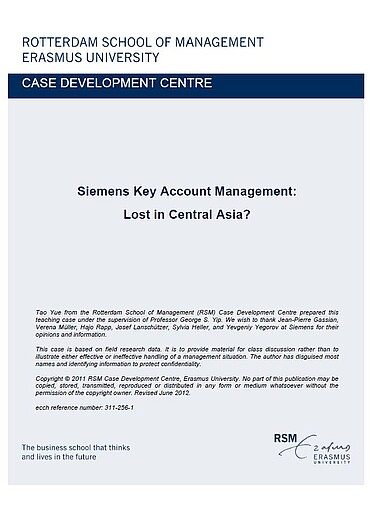Citation Note
Based on field research; 11 pages.
Follow the 'handle' link to access the Case Study on RePub.
For EUR staff members: the Teaching Note is available on request, you can contact us at rsm.nl/cdc/contact/
For external users: follow the link to purchase the Case Study and the Teaching Note.
Objective
This case serves four main objectives: 1. To understand the complexity and intricacy of global KAM. 2. To understand the three forms of global KAM, their evolvement, advantages, and disadvantages. 3. To analyze the relationship between global integration capacities and the different KAM forms. 4. To explore how to strike a balance between global integration and local autonomy. If used in an executive program, the case also helps answer the following questions that concern many managers of multinational firms: 5. Should a supplier adopt the KAM approach? 6. How to choose the right customers as candidates for key accounts? 7. Which form of KAM is most suitable for a specific customer? 8. How to customize the KAM program for the customer in order to achieve best return?
description
While Siemens Key Account Management program was a proven success, Siemens encountered major challenges in managing a key account in Central Asia. How an MNE like Siemens can strike a balance between global integration and local autonomy became an urgent issue to resolve.
Abstract
Since the mid-1990s, Siemens AG has adapted its business processes and internal structure to the expected future competitive environment in order to make the company faster, more focused, and more efficient. In this effort, customer-centric KAM programs (Siemens One) have evolved. Siemens One is a proven success that helped the company get through the financial crisis by cutting costs, focusing on core business, and strengthening customer relationships. While Siemens One continues to mature day by day, Siemens still encounters challenges in managing key accounts at the national or regional level. The case uses Siemens KAM program for EuroBric in Tamerstan as an example to illustrate two main issues that currently face the company: 1) How to align practices of two equally complex multinational organizations, and 2) How to strike a balance between global integration and local autonomy.
usage
Designing programs to serve global accounts has been a painful and often un-profit art. This case helps the reader understand the major barriers to effective key account management and the solutions to these barriers. The case received attention and compliment from Siemens CEO at an industry conference in 2011.
